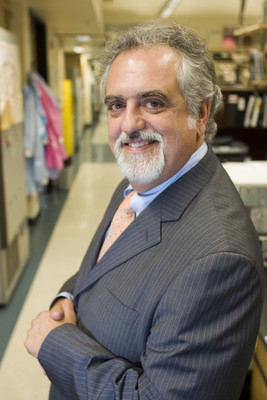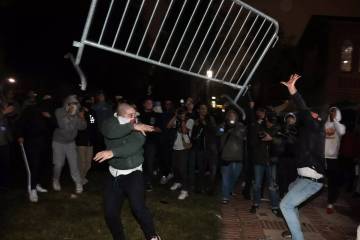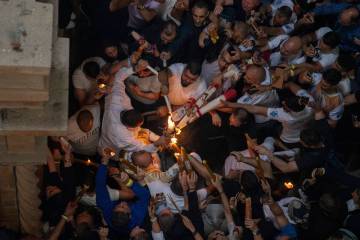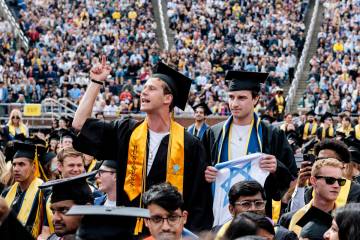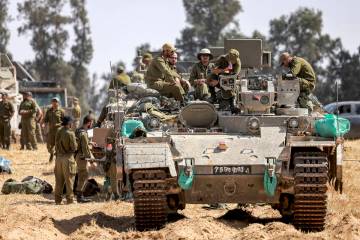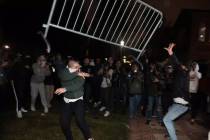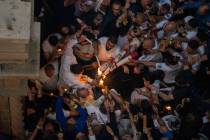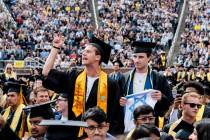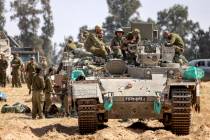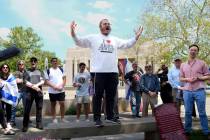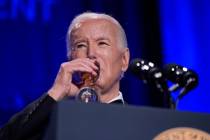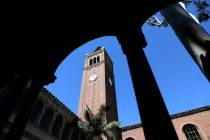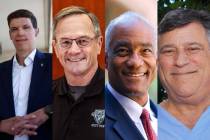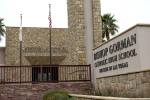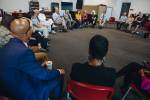Doctor leads state’s health care revival
If you believe the hype, then Dr. Maurizio Trevisan will become one of the most important people in Nevada in the next few years.
Some expect Trevisan, the new head of the University of Nevada Health Sciences System, to rescue the state's medical care system from the lowest rungs of national rankings.
As the top health care officer in the state's higher education system, he's been given the job of coordinating the efforts of the state's two universities and five colleges with those of medical care providers, such as the Nevada Cancer Institute and local hospitals.
It is a monumental task.
He will have to juggle the egos of state and company officials; raise millions of fundraising dollars; fight decades of bureaucracy in the state's colleges and universities.
And he has one of the most demanding and bombastic bosses around: university system Chancellor Jim Rogers, for whom the project is a personal vision.
Trevisan will be carrying out that vision with a handful of staff, and in a position no higher or lower than that of a university president.
The 55-year-old Trevisan has been dubbed a "superstar" by Rogers and has the highest salary in the Nevada System of Higher Education, at $415,000, to back it up.
What Nevadans are getting for the price tag is an avid researcher and multitasker; a man who is familiar with and devoted to community health care issues, his former colleagues say; and a man who sees Nevada as the next inception of his own vision for health care.
"My goal is for that, years from now, people can look at Nevada and say, 'Look at what a great system they have -- a great system in health care, (and) how impactful this system is for the health of the people in Nevada,' " said Trevisan with a thick Italian accent, the product of his upbringing and education in Naples, Italy.
His former colleagues at the State University of New York at Buffalo call his personality "genuine," his ideas "outside the box."
"I called him 'King Midas' because everything he touched really just turned to gold," said Holly Balmer, who was assistant to the dean when Trevisan was dean of SUNY-Buffalo's School of Public Health and Health Professions.
Even if you haven't heard of Trevisan, you probably have heard of his research.
He has led studies showing that reasonable amounts of wine can be good for you, that bald men have higher cholesterol levels than their less follicularly challenged peers and that olive oil might help fight heart disease and cholesterol.
He has been quoted in the New York Times and the Los Angeles Times, and his research has appeared in the top medical journals in the country, including the New England Journal of Medicine.
He's working on a study linking periodontal, or gum, disease to a higher risk of heart disease. He is applying for a National Institutes of Health grant to follow up on the study.
Research is his passion, he said, much of it done during his 22-year tenure at SUNY-Buffalo. Publicity from the studies "made us look great," said Dr. David Dunn, vice president for health sciences at the university.
In Nevada, Trevisan is venturing into uncharted territory with the Health Sciences System.
He envisions that cancer specialists at the University of Nevada School of Medicine would work with the Nevada Cancer Institute, researchers at UNLV would partner with the Lou Ruvo Brain Institute, and students in nursing would partner with county health agencies and state hospitals.
Other states have formed academic medical centers that focus on the immediate community.
Southern California has Loma Linda University Adventist Health Sciences Center, for example, which combines a medical school with a hospital and a children's hospital and serves the surrounding area.
Trevisan wants to take that model and form a system for the entire state, which, as far as anyone knows, has never been done before anywhere in the country.
"It's clear that in order to have a strong hospital, they (hospitals) need to be connected to an academic system," he said.
"The academic institutions need to be relevant in the community, and while they pursue relevance, they can pursue academic excellence," he said.
If this sounds somewhat vague to you, you're not alone. But Trevisan, who has been on the job for two weeks, last month shared some details of what the system might become.
His immediate goals include establishing a joint school of public health between the University of Nevada, Reno and the University of Nevada, Las Vegas.
He also insists that Nevada's university and college classrooms be equipped with teleconferencing equipment, so that students in rural Nevada can take virtual medical classes from UNLV and UNR professors.
Course curriculums will become standardized among state institutions. Fields will become interdisciplinary.
"What I tried to do in Buffalo was break down the walls between schools," Trevisan said. "Out here, what I want to do is break down walls between institutions."
Yet he has a host of serious obstacles to overcome, not the least of which is mass confusion, even among other higher education officials, over what exactly the Health Sciences System is.
"Identity crisis is what this whole project is suffering from," university system Executive Vice Chancellor Daniel Klaich said two weeks ago during a Board of Regents Health Sciences System committee meeting.
Regents and others have struggled to understand and explain the system because it's still in its conceptual phase.
"There's certainly going to be some challenges," said Bill Welch, CEO of the Nevada Hospital Association, which is working with Trevisan and supports the Health Sciences System. "It's a little bit nebulous because it's very philosophical."
Some regents are starting to worry that the confusion could cause lawmakers to cut off funding to the project.
It received nearly $90 million from the Legislature this year, but that money requires nearly $40 million in donations in order to be unlocked.
"The challenge is in the details," Trevisan admitted. "Everybody loves the idea, but people may be more or less skeptical about whether or not it's possible."
Trevisan's past at SUNY-Buffalo, where he built a similar, smaller system, could provide the best glimpse into whether he will become successful in Nevada.
Colleagues there praised him for his efforts to found the School of Public Health, which combined a host of different schools, degrees and departments and refocused efforts toward the community.
"It's sometimes kind of difficult to change academia, to change the structure," said Balmer, who was assistant to the dean when Trevisan was the founding dean. "He really thought outside the box in a lot of different areas."
He taught "just because you've done it this way for 100 years doesn't mean it's the best way. He got them (academics) out of their comfort zone, but made them comfortable with it."
To focus on the community of Western New York, Trevisan created an advisory council of academics and community health leaders, and appointed Dr. Arthur Goshin, the founding CEO of a New York insurance provider, the chairman of the board.
"His personality is bringing people together in a non-threatening way," Goshin said. "A lot of people have troubles in those roles, where egos need to be stroked and recognized, and that's not trouble for him. He's a servant of the public interest rather than a servant for his own interests."
Dunn, who was Trevisan's boss, said he was focused on the community.
To combat societal problems such as rampant obesity and heart disease, Trevisan would combine resources to come up with public health solutions, Dunn said.
"That's not your typical academic approach," he added.
Trevisan is hoping to shake up a similar system here, albeit on a much larger scale.
"The future is without boundaries: long-distance education, webcasting, podcasting," Trevisan said. "There is really no reason why students and teachers should be restrained by campus or geographic boundaries."
Contact reporter Lawrence Mower at lmower@reviewjournal.com or (702) 383-0440.



